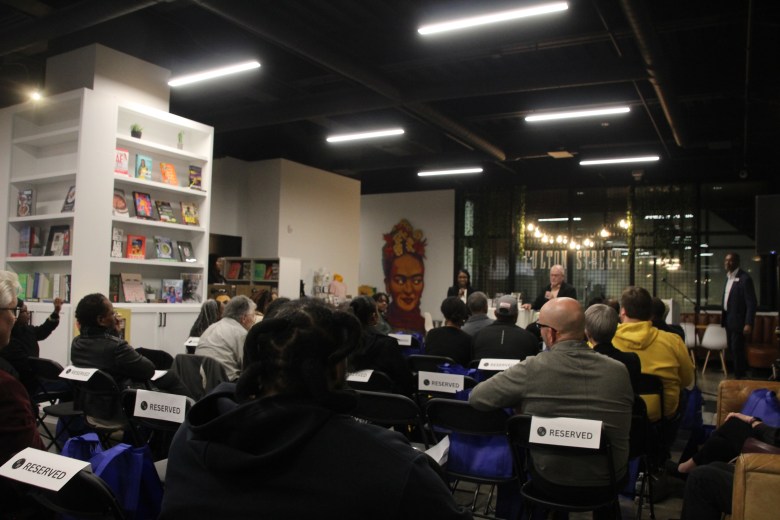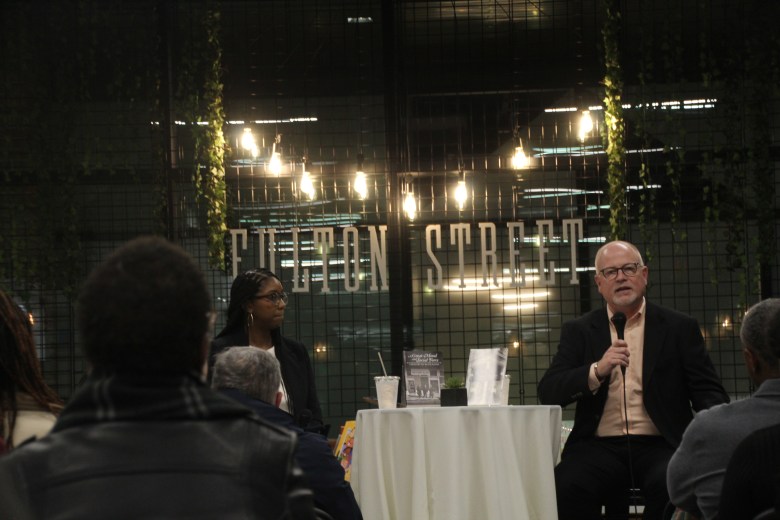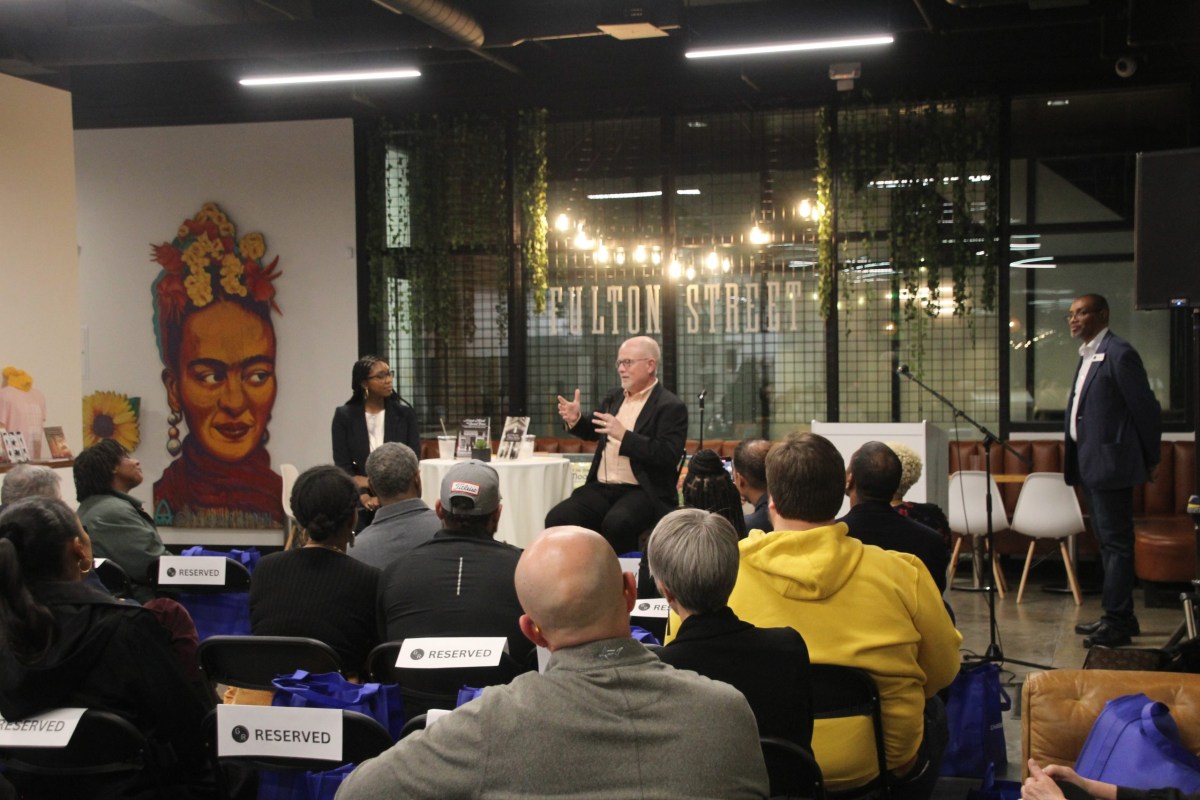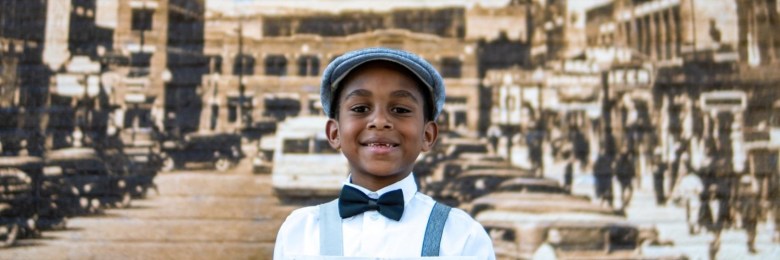|
Listen to this article here
Getting your Trinity Audio player ready...
|
By Ashley Jones
GREENWOOD Dist.–History shows Black banks thrived in times of activism and community, and their decline was mainly attributed to economic downturns in the nation that disproportionately affected them.
Kansas City Federal Reserve Author and Historian Tim Todd wrote the book on black banking because he said no one else had.
He shared insight into his research findings for his two books on the history of Black-owned banking at an event hosted by Chase Bank nearing the finale of Black History Month at Fulton Street Books and Coffee on Black Wall Street in Tulsa’s Historic Greenwood District.

In Todd’s opening remarks, he prefaced the motive behind the Federal Reserve publishing free books available to the public on the history of Black banks.
“My superiors believe very firmly that we need to understand the history to really understand where we are today, and then you can overlay it with the wealth gap,” Todd said.
Black Banks and MDI numbers dwindling
Back in the early 2000s, the United States had around 50 Black-owned banks, small community based institutions. Now, there’s about 22 that are still in business. And It’s not reflective of other minority depository institutions (MDI) which have maintained steady numbers for serving their community. The decline can be attributed to the economic pitfalls such as COVID and the financial crisis of 2007-2008, according to Tim Todd.
“The Black community was hit disproportionately hard,” Todd said. “People were taken advantage of on some of their mortgages, but not by banks, but by others, that affects the whole community.”
That’s why the Fed has interest rooted in educating the history of Black-owned banks–to stop its rapid decline, because the impact of them closing for the racial wealth gap is damaging.
MDIs are important in serving minority communities, and they’re key lenders for small businesses, mortgage lending, and emergency expenses (unexpected medical bills or home repairs). After an MDI closes, Todd says it’s very unlikely that another depository institution is stepping into that space.
“That’s going to leave the community vulnerable to title loans, payday lenders, pawn shops, check cashing services that begin to proliferate in these areas, and then that can lead folks to a death spiral,” Todd said.
“So those places can really damage someone’s credit and financial situation. At the Fed we’re concerned about the economy, opportunity, particularly access to credit, being treated fairly. So that’s why the Fed is interested in this stuff.”
Lessons to be Learned from Black Banks Thriving through Activism
There was a lot to learn from the history of Black banks, like the fact that a good number of them had once fallen off before during the great depression. Todd says it was the civil rights movement where the numbers began to thrive once more.
“All of these banks, they were all created with a vision,” Todd said. “And so you continually find across history, these banks are at the intersection of some very important historical events- that’s Dr. King and that’s on the South Side of Chicago during the red summer. Different points in history, you find banks serving their communities better with this vision of community service.”
In his second book on the history of Black banks, A Great Moral and Social Force, Todd talks about the success of Black banks throughout time starting in Richmond, Virginia, where the first banks were created.
He brought up Oklahoma, as people moved to the plains from the south, then the upper midwest area of Chicago, the beginning of migration and industrialization there, and then down to Memphis and later Detroit for the civil rights era.
In each time period, Black banks rose in popularity and wealth because they were focused on building a community and coming together for a cause.
“What lessons can you draw from that, you asked?” Todd asked moderator Ashley Townsend, Tulsa’s Chase Bank Community Manager.
“As a bank, you need to think about when you hire people, you know, don’t just hire the financial wizard, hire someone like yourself, who gets motivation out of helping the community and then teach them that financial stuff and try to bring it in.”
Chase Bank on Building Racial Equity
Chase Bank placed community managers in major cities nationwide, including Tulsa, as part of a $30 billion racial equity commitment to help close the racial wealth gap and advance economic inclusion among Blacks, Hispanic, Latinx and other underserved communities.
“Our dedication to Oklahoma is apparent throughout our branch presence with over $3.1 million in philanthropic contributions and more than 900 workers who call Oklahoma home,” Bridget Killings said.
Townsend hosts financial literacy classes available for free to the Tulsa Community. The next one following the Black history event will be Friday, April 12th, from 1 p.m. to 2 p.m. at the Chase Bank branch on 61st and Lewis.
“Generational wealth doesn’t have to be just money, but we can also pass down generational knowledge and resources to our family instead of living paycheck to paycheck,” Townsend said.

“We can get those resources now. It’s never too late to learn how to budget, how to save and how to build your credit. And we can pass that information down to our kids as well so that they can get the money for generational wealth.”
Oklahoma and Black Banks
One piece of wisdom Todd shared, which Townsend found fascinating, was the fact that Black Wall Street before the 1921 Tulsa Race Massacre had no Black-owned banks. The main reason being, they were so wealthy there wasn’t a dire need for them.
Historically, in the United States, banks have been created in situations where the people are collectively considered poor. The idea is reflected in the title of Todd’s first book, Let Us Put Our Money Together. That creates a source of loanable funds that can be loaned out to the community and it can attract businesses.
“Banks generally started when people had very little. Tulsa was a different environment,” Todd said, referring to Black Wall Street. “And so the jobs compared to other areas of the United States were well paid. And then you also had the developers and you had the private lenders here, who actually helped to finance everything. Some of them had relationships with some of the wider banks in the city.”
In Todd’s book, A Great Moral and Social Force, he credits O.W. Gurley as a wealthy developer in Black Wall Street that would lend money to other businesses. And the donations sent to the city after the Massacre were tracked going into Boley, Oklahoma- a Black town that was known for its Black-owned banks.
“Boley was very innovative, and DJ Turner founded a bank that was the anchor of that community,” Todd said. “You have the National Negro Business League and members there who had a meeting, so it’s really a leading strong, vibrant community.”
Most Black banks are located in the Southeast part of the United States, and Todd said Oklahoma had much to do with that. From the blending of cultures with Native Americans to the debate of making Oklahoma a Black state with 50 all-Black towns, Oklahoma generated a lot of wealth.
Changing the Narrative
“One of the things when we wrote the first book, we were kind of trying to refute this idea when people would say, ‘the Black community just doesn’t trust banks. They don’t like banks,’” Todd said.
“Well, I can certainly understand why they wouldn’t trust banks. History can make that lesson very clear to me, but it’s not true that there weren’t Black banks that weren’t successful. There were, they were very successful, they did amazing things. I think it’s about getting people to sort of change the way they think about the bank or the relationship, and they recognize we’re creating opportunity for someone by relationship with a banker.”
Todd ended his discussion after a Q&A from the audience and afterward he signed everyone’s books. The most memorable portion of the night for participant Roxanne Stewart was how it changed her view of banking.
“I think one of the biggest things that he said was the fact that when you have a savings account it will give somebody an opportunity, and where the opportunity is being deposited makes a difference.”


